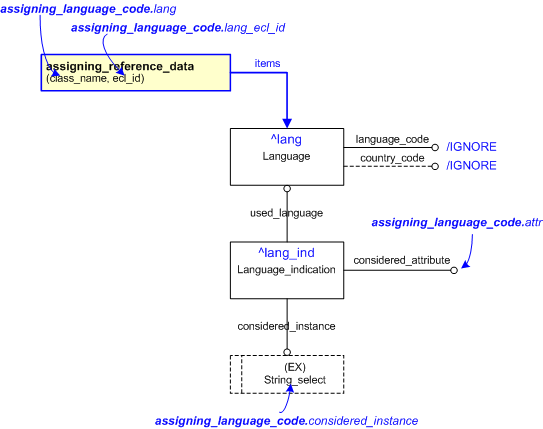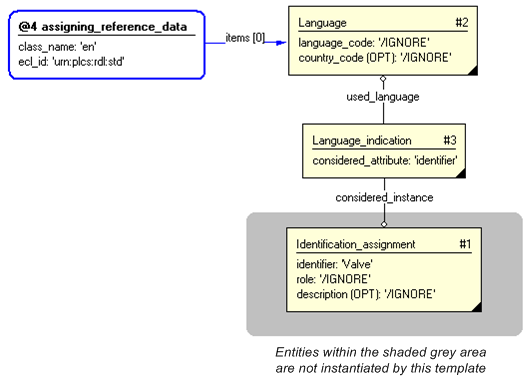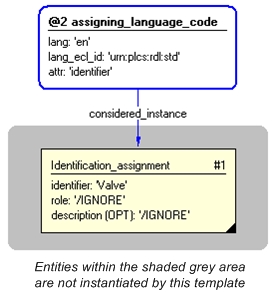Template:— assigning_language_code (asg_lang_code)
Context:— FMV |
Date: 2008/02/05 12:07:42
Revision: 1.3
|
This section specifies the template assigning_language_code.
NOTE
The template has been defined in the context of
FMV.
Refer to the business context for details of related templates.
NOTE
An explanation of a template and the associated instantiation path is
provided in the
Template overview
section.
This template describes how to represent the assignment of a language code to an entity attribute.
The EXPRESS-G diagram in
Figure
1
shows the templates and EXPRESS entities that are required
to represent the template
"assigning_language_code".
The text highlighted in blue shows the template parameters.
Figure 1 — An EXPRESS-G representation of the Information model for assigning_language_code
The graphic for the template to be used in other EXPRESS-G diagrams
is shown in Figure
2
below.
Figure 2 — The graphical representation of the assigning_language_code template
The following input parameters are defined for this template:
The following classes and their sub-classes can be used:
The name of the attribute to which the language code applies.
The entity to which the language indication is assigned.
The following reference parameters are defined for this template:
Allow the
Language
entity instantiated in this path to be referenced when this template is used.
Note: The
Language
entity can be referenced in a template path by:
%^target = $assigning_language_code.lang%
where
target
is the parameter to which the
Language
is bound.
Allow the
Language_indication
entity instantiated in this path to be referenced when this template is used.
%^target = $assigning_language_code.lang_ind%
The following parameter combinations specify a uniqueness constraint:
Unique constraint: Unique language
Each instance of the
entity
(
Language)
within the data set shall be uniquely identified
by a combination of the following parameters on this
template (assigning_language_code) namely:
lang,
lang_ecl_id.
The
instance is
referenced by the following template parameter:
lang.
This rule means that there can be only one instance of a language code within a data set
(
Language ).
Unique constraint: Unique language indication
This rule means that there can be only one instance of a language code being assigned to the same attribute of an
entity instance within a data set
(
Language_indication ).
The instantiation path shown below specifies the entities that are to be
instantiated by the template.
A description of templates and the syntax for the instantiation path is
provided in the
Templates Help/Information section.
The following entities are instantiated with attributes as specified:
The instance diagram in Figure
3
shows an example of the EXPRESS entities and templates that are instantiated by the template:
/assigning_language_code(lang='en', lang_ecl_id='urn:plcs:rdl:std', attr='identifier', considered_instance='#1')/
(an illustration of the consolidated assigning_language_code template is shown in
Figure
4 below.)
Figure 3 — Entities instantiated by assigning_language_code template
The instance diagram in
Figure
4
shows the graphic symbol for the template that is to be
used in other instance diagrams. The example template is:
/assigning_language_code(lang='en', lang_ecl_id='urn:plcs:rdl:std', attr='identifier', considered_instance='#1')/
Figure 4 — Instantiation of assigning_language_code template
Characterizations
No common characterizations of the template
assigning_language_code
have been identified. However, the ISO 10303-239 EXPRESS model
may enable other assignments to the entities instantiated by the template.




